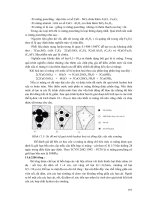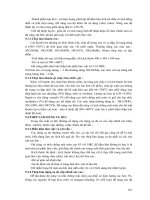Sử dụng tảo làm nguồn nhiên liệu sinh học
Bạn đang xem bản rút gọn của tài liệu. Xem và tải ngay bản đầy đủ của tài liệu tại đây (2.6 MB, 37 trang )
HO CHI MINH CITY INDUSTRIAL UNIVERSITY
CHEMICAL ENGINEERING FACULTY
Use of algae as biofuel sources
Presented by:
Lê Huỳnh Đức _ 15073651
Thái Thị Thảo Anh_15081221
Biofuels
Introduction to biofuels
Biofuel concept
- Biomass Fuel is a fuel formed from compounds of plant and animal origin
- As fuel derived from animal and plant fat, agricultural waste, ...
Classification Biofuel
Biodiesel
It is a liquid fuel
used to replace
traditional disel oil
Bio-fuel
A liquid fuel that
uses ethanol
blended into
gasoline instead of
lead additives
Biogas
Organic
Organic gases
include methane
and other peers
Biofuels
Biodiesel
Biodiesel concept
- Biodiesel is a fuel that is equivalent in fuel to disel oil but is not produced from
petroleum but is produced from vegetable oil and animal fat..
Raw materials for biodiesel production
- The source of raw materials for biodiesel production is mainly from new or used
animal and vegetable fats and oils.
- Currently, the debate over the balance between food security and security Energy
has led to the use of unused vegetable oil sources in food as well as waste oil and waste
as raw materials biodiesel production.
Biodiesel
-Biodiesel is a mixture of fatty acids and akyl esters obtained through ester
transposition of vegetable oils or animal fats. Sources of vegetable oil or lipid lipid
include 90-98% by weight of triglycerides and a small amount of mono and
diglycerides, free fatty acids make up about 1-5% of the rest such as phospholipids,
carotene, sulfur and 1 little water
Biodiesel
Biodiesel fuel is divided into 3 generations
1nd generation
2nd generation
3nd generation
Subtrate:
Seeds, grains
of sugar
Bioethanol by
ferentation of
starch (wheat,
barly, corn,
potato) or
sugars.
Bioethanol
produced
from plant
biomass as
agricultural
waste of rice,
corn and
wheat stalks.
Bioethanol
from
microalgae and
sea weeds.
Hydrogen
from green
microalgae and
microbes
Biodiesel
Statistics of total biodiesel production
On the world
- 2000-2006: total biodiesel
production increased by 32%.
- 2007: total production tripled
- 2006 - 2008: total biodiesel
production increased by 115%.
- Europe: world leader in
biodiesel production and
consumption (185 + 58
factories).
- 2012: America becomes the
world's top biodiesel consumer
market..
Biodiesel
Statistics of total biodiesel production
USA
2004: Produces 25,000,000
gallons.
2005: produces 75,000,000
gallons (53 factories).
1/2/2018: The world's first
biodiesel production plant, 4.4
million gallons per year.
Currently: 329,000,000 gallons
/ year (~ 100 factories)
Biodiesel
Statistics of total biodiesel production
Italia
Argentina
2008: 3 times more production
and the third largest biodiesel
producer in the world.
2009:
expected to double the
number of biodiesel plants
compared to 2008 (~ 70
factories).
2010: compulsory use of B5
nationwide.
2008: production of 600,000
tons / year, total biodiesel
production increased by 28%,
total capacity of biodiesel plants
increased by 42%.
2009: expected to increase
production to 8,000,000 tons /
year.
Malaysia
2007: The first factory
produced 110,000 tons of
biodiesel per year from palm
oil.
Algae
Concept
- As a group of low-level plants living in a water environment, there is optical
ability Combine, absorb light and transform light, water, CO2 energy into biomass, at
the same time release O2.
Classification algae
Micro algae
Big algae
Size microscopic, monoclinic
or multicellular live in
suspension in water
These are multicellular algae
of large size, can reach a
length of 3048cm
Algae
Algae
Oil content in some types of microalgae in
2007
Why do we choose algae as biofuel?
• We can be grown on marginal land useless for
conventional crops.
• High yield per acre (4046.86 m2) has a 1-10
day harvest cycle
• We can be grown with minimal impact on
freshwater sources
• We can be grown by emissions from power
plants as a source of CO2
• It is possible to convert a much higher
biomass to oil than conventional crops, for
example 60% compared to 2-3% for
soybeans.
Algae
Advantages and disadvantages of algae
Advantages
Disadvantages
- Contains high oil content.
- High cost.
- Growing faster than other
plants.
- Not easy to exploit
- Create renewable energy
sources to clean the
environment
Algae
Algae production technology
Algae
Algae production technology
Catalysis
•
A process that changes the speed of a chemical reaction of one or more
reactants, thanks to the involvement of an additive called a catalyst.
Catalysis
Catalysis
Biological catalyst
Biological catalyst is called an enzyme.
Enzyme works by lowering the activation energy of a given
biological reaction. This keeps the organisms heating up too
much, which will disrupt other organ reactions
Catalysis
Effect of time
Factors affecting
enzyme catalysis
Effect of environmental
pH
Effect of temperature
Effect of enzyme
concentration
Catalysis
Introduction of lipase catalysis
•
Lipase is an enzyme that catalyzes fat
hydrolysis (lipid) . Lipase is a water-soluble
enzyme and polar solvents Other, insoluble in
ether and non-polar solvents.
• Lipase is also known as Triacylglycerol lipase.
Is a water-soluble enzyme that catalyzes the
hydrolysis of triacylglycerol. Water-insoluble
forms glyceril and corresponding fatty acids
thanks to its activity on oil-water-soluble
surface. Lipase catalyzes the hydrolysis
reaction to cut α-ester bonds in turn and not
cut three bonds at once. The catalytic process
is usually slower than other enzymes such as
protease, amylase ...
Catalysis
Lipase enzyme model
Catalysis
Transester reaction of triglyceride and fatty acid
with lipase catalysis
Catalysis
Transester reaction of triglyceride and fatty acid
with lipase catalysis
Catalysis
Mechanism to react with lipase catalysts









